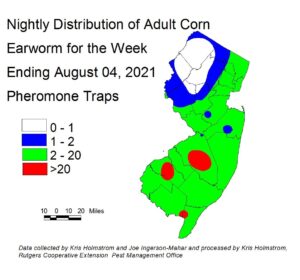Sweet Corn
European corn borer (ECB) moths have been captured at a few more locations over the past week, although recording sites are relatively few and numbers are very low. ECB population maps will resume if second flight catches rise to high enough numbers.
The highest nightly trap catches of ECB for the week ending 08/04/21 are as follows:
| Blairstown 1 | Hillsborough 1 | New Egypt 1 |
| Downer 1 | Medford 1 | |
| Flanders 1 | Milltown 1 |
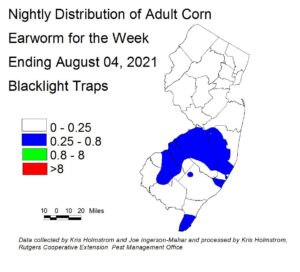 Corn earworm (CEW) moths captures from blacklight traps remain quite low, and while pheromone trap captures are significantly higher, they have declined somewhat from a week ago. Elevated pheromone catches remain at a few sites in Burlington, Gloucester and Cape May counties. North Carolina trap catches appear to be rising over the past week, although variable according to region. Delaware catches remain in range with southern New Jersey. Generally we see our larger influx of CEW adults after the first week of August. Check this publication weekly for CEW status. The number of pheromone traps deployed is much lower, resulting in much broader color bands on the map. It is also important to understand that pheromone traps are more sensitive than blacklight traps, and thresholds are adjusted to account for the higher catches typical of this trap type. Silking corn is at risk of CEW infestation at this time. On the blacklight map (left), green areas represent a 3-4 day silk spray schedule and blue represents a 4-5 day schedule. On the pheromone map (below right), red represents a 3 day spray schedule, green represents a 4-5 day schedule, and blue represents a 5-6 day schedule. Be sure to access information from this publication in the upcoming weeks to determine how frequently you should treat silking sweet corn to protect it from CEW infestation.
Corn earworm (CEW) moths captures from blacklight traps remain quite low, and while pheromone trap captures are significantly higher, they have declined somewhat from a week ago. Elevated pheromone catches remain at a few sites in Burlington, Gloucester and Cape May counties. North Carolina trap catches appear to be rising over the past week, although variable according to region. Delaware catches remain in range with southern New Jersey. Generally we see our larger influx of CEW adults after the first week of August. Check this publication weekly for CEW status. The number of pheromone traps deployed is much lower, resulting in much broader color bands on the map. It is also important to understand that pheromone traps are more sensitive than blacklight traps, and thresholds are adjusted to account for the higher catches typical of this trap type. Silking corn is at risk of CEW infestation at this time. On the blacklight map (left), green areas represent a 3-4 day silk spray schedule and blue represents a 4-5 day schedule. On the pheromone map (below right), red represents a 3 day spray schedule, green represents a 4-5 day schedule, and blue represents a 5-6 day schedule. Be sure to access information from this publication in the upcoming weeks to determine how frequently you should treat silking sweet corn to protect it from CEW infestation.
The highest nightly blacklight trap catches of CEW for the week ending 08/04/21 are as follows:
| Cinnaminson 1 | Farmingdale 1 | Long Valley 1 |
| Crosswicks 1 | Folsom 1 | Medford 1 |
| Denville 1 | Georgetown 1 | New Egypt 1 |
| Downer 1 | Green Creek 1 | Tabernacle 1 |
The highest nightly pheromone trap catches of CEW for the week ending 08/04/21 are as follows:
| Tabernacle 43 | Pedricktown 10 | Woodstown 4 |
| Eldora 27 | East Vineland 9 | Elm 3 |
| Green Creek 23 | Beckett 7 | Snyder Farm (Hunterdon) 2 |
| Monroeville 20 | Matawan 5 | Dayton 2 |
Silking Spray Schedules*:
South – 3-4 days
Central – 4-5 days
North – 5-6 days
*These recommendations are based on regional catches. Adhere to tighter spray schedules if indicated by local trap catches. Synthetic pyrethroids alone should NOT be used for corn earworm (CEW) protection on silking corn, or for fall armyworm (FAW) management at any stage. Control with these materials is very inconsistent. Utilize materials in IRAC groups 5 and 28, or combination products that include IRAC group 28 for best control. See the Sweet Corn section of the 2020-21 Commercial Vegetable Production Guide for selections.
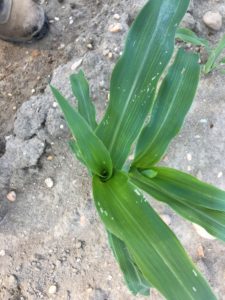
 Fall armyworm (FAW) larval infestations remain relatively low, but are present in all parts of the state. Injury from newly hatched larvae shows up as “window panes” or areas where leaf tissue has been eaten down the the lower epidermis (see photo at far left). This injury leads down into the whorl. As larvae gain size, they begin to consume leaf tissue in its’ entirety, creating ragged holes and lots of droppings (see photo at near left). FAW can be tough to manage because it is resistant to synthetic pyrethroid insecticides (IRAC 3A) and because larvae are often covered by their own droppings, making contact with the insecticide more difficult. Treat when 12% or more plants exhibit FAW injury alone, or in combination with ECB injury. As a rule, insecticides that are most effective on CEW will also adequately control FAW.
Fall armyworm (FAW) larval infestations remain relatively low, but are present in all parts of the state. Injury from newly hatched larvae shows up as “window panes” or areas where leaf tissue has been eaten down the the lower epidermis (see photo at far left). This injury leads down into the whorl. As larvae gain size, they begin to consume leaf tissue in its’ entirety, creating ragged holes and lots of droppings (see photo at near left). FAW can be tough to manage because it is resistant to synthetic pyrethroid insecticides (IRAC 3A) and because larvae are often covered by their own droppings, making contact with the insecticide more difficult. Treat when 12% or more plants exhibit FAW injury alone, or in combination with ECB injury. As a rule, insecticides that are most effective on CEW will also adequately control FAW.
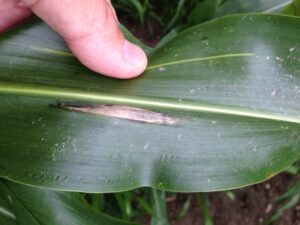 The first incidence of northern corn leaf blight (NCLB) has been detected in northern NJ this week (see photo at left). This fungal disease can increase in severity with longer dew periods that typically occur in August-September. Lesions may form on husks, making them unsightly. Heavy infections can result in reduced ear size. When scouting, note the presence of these lesions, particularly if they first appear in whorl stage sweet corn. Fungicides may be required to limit infections. Useful materials include fungicides in FRAC codes 3,7 and 11, and may be found in the Sweet Corn section of the 2020-21 Commercial Vegetable Recommendations.
The first incidence of northern corn leaf blight (NCLB) has been detected in northern NJ this week (see photo at left). This fungal disease can increase in severity with longer dew periods that typically occur in August-September. Lesions may form on husks, making them unsightly. Heavy infections can result in reduced ear size. When scouting, note the presence of these lesions, particularly if they first appear in whorl stage sweet corn. Fungicides may be required to limit infections. Useful materials include fungicides in FRAC codes 3,7 and 11, and may be found in the Sweet Corn section of the 2020-21 Commercial Vegetable Recommendations.
Tomatoes

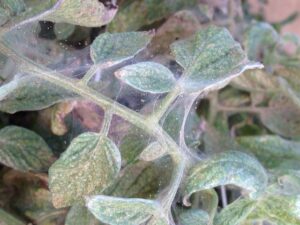 Two-spotted spider mite (TSSM) infestations are becoming more common in scouted tomato plantings. These pests multiply rapidly, and can cause severe defoliation under high temperature conditions if not detected early. Look for leaflets exhibiting pin spots (left) on the upper surface. These leaflets will become yellow as TSSM numbers increase. Mites may be observed on the underside of leaves showing these signs. Extreme infestations will result in extensive webbing being produced on top of foliage (right). Treatment should be undertaken when mites are first detected, because larger established infestations are quite difficult to control. Spot treatments may be effective if the infestation is limited. See the Tomato Section of the 2020-21 Commercial Veg. Recs. for details on effective materials.
Two-spotted spider mite (TSSM) infestations are becoming more common in scouted tomato plantings. These pests multiply rapidly, and can cause severe defoliation under high temperature conditions if not detected early. Look for leaflets exhibiting pin spots (left) on the upper surface. These leaflets will become yellow as TSSM numbers increase. Mites may be observed on the underside of leaves showing these signs. Extreme infestations will result in extensive webbing being produced on top of foliage (right). Treatment should be undertaken when mites are first detected, because larger established infestations are quite difficult to control. Spot treatments may be effective if the infestation is limited. See the Tomato Section of the 2020-21 Commercial Veg. Recs. for details on effective materials.
Peppers
Pepper weevil – Traps are deployed, and we have still captured no weevils in pheromone traps. We are not aware of any fields having infestations. We normally find the most infestations in August. That we haven’t trapped any weevils is a good thing. A new fact sheet is now available for anyone interested in monitoring for pepper weevils on their own: FS1330: Monitoring and Management of Pepper Weevil in New Jersey (Rutgers NJAES).
Pumpkins and Winter Squash
Cucurbit downy mildew (CDM) is active on cucumbers in all parts of the state, and is infecting cantaloupes in southern NJ at this time. As yet, other cucurbits, including pumpkins, butternut squash, acorn squash and watermelons are unaffected. For regional information on this important disease, see the Cucurbit Downy Mildew Forecast webpage: http://cdm.ipmpipe.org/. This forecast has southern NJ at moderate risk of further infection through Tuesday 8/03. Note however, that active infections will persist and increase locally with repeated rain and heavy dew events. It is advisable that all growers treat preventively for CDM on cucumbers and muskmelons. As yet, there have been no reports in the region of CDM affecting any other cucurbit crops. This is important, as pumpkins and winter squash are now active crops in the region.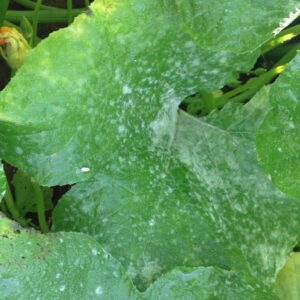
Pumpkin fields in the scouting program are now developing powdery mildew (PM) lesions (right). It is expected that by next week, most fields will have exceeded the action threshold (2 lesions/100 older leaves) to initiate the powdery mildew fungicide program. For a list of effective materials and fungicide rotations, see the Pumpkin/Winter Squash section of the 2020-21 Commercial Veg. Recs.
Brown marmorated stink bug (BMSB)
BMSB trap catches remain very low. No map will appear in this addition.
